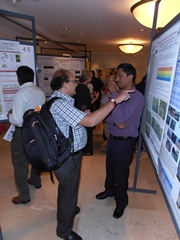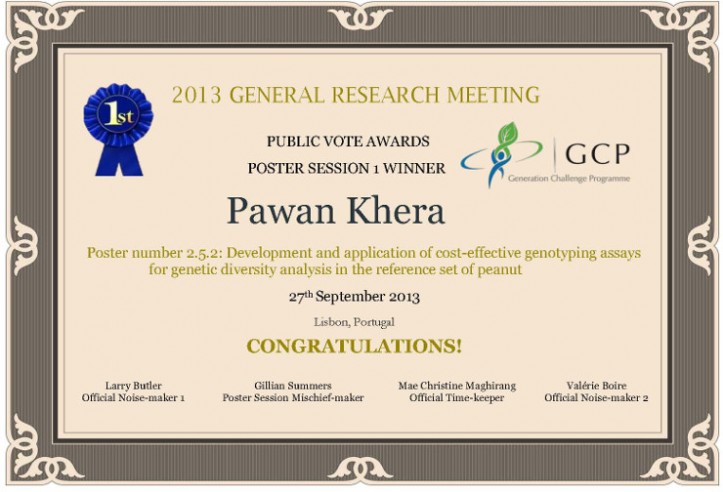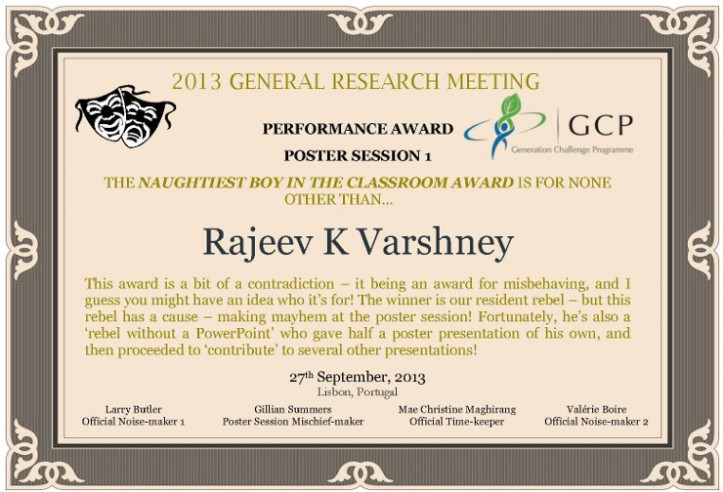| Number |
Title |
Lead author
|
Poster presenter |
1. Cassava
Back to top
|
| 1.1 |
Analysis of inbreeding depression in five S1 cassava families of African varieties |
Emmanuel Okogbenin |
Emmanuel Okogbenin |
| 1.2 |
Genetic variability of six cassava traits across three locations in Ghana |
Bright Boakye Peprah |
Bright Boakye Peprah |
2. Legumes
Back to top |
| 2.2 Beans |
| 2.2.1 |
SNP marker development to improve marker assisted selection at CIAT bean breeding program
|
Bodo Raatz |
Bodo Raatz |
2.3 Chickpeas
Back to top |
| 2.3.1 |
Improve chickpea productivity for marginal environments in Sub-Saharan Africa and Asia- Phase II |
Mahendar Thudi |
Mahendar Thudi |
| 2.3.2 |
Harnessing the potential of multi parent advanced generation inter cross (MAGIC) populations for gene discovery and breeding applications in chickpeas |
Pooran Gaur |
Mahendar Thudi |
| 2.3.3 |
Use of marker-assisted breeding to improve drought tolerance in chickpea |
Paul Kimurto |
|
2.4 Cowpeas
Back to top |
| 2.4.1 |
Cowpea diversity for modern breeding in sub-Saharan Africa
|
Bao Lam Huynh
|
Bao Lam Huynh |
2.4.2 –
EXTRA POSTER |
Development of Maruca and Striga resistances in cowpea using quick ELISA test and MAS in back-crossed populations BC1F1S |
Jean-Baptiste Tignegre |
Jean-Baptiste Tignegre |
2.5 Groundnuts
Back to top |
| 2.5.1 |
Three elite peanut cultivars improved for rust resistance by introgressing a QTL genomic region through marker-assisted backcrossing (MABC) approach
|
Rajeev K Varshney
|
Rajeev K Varshney |
| 2.5.2 |
Development and application of cost-effective genotyping assays for genetic diversity analysis in the reference set of peanut (Arachis spp.)
|
Pawan Khera |
Pawan Khera |
| 2.5.3 |
Widening the gene pool of cultivated peanut using wild relatives: AB-QTL and CSSL development |
Daniel Fonceka
|
Daniel Fonceka |
2.5.4
|
Identification of Quantitative Trait Loci for yield and yield related traits of peanut (Arachis hypogaea L.) using a recombinant inbred lines population |
Issa Faye
|
Issa Faye |
| 2.5.5 |
Improving groundnut productivity through resilience to the biotic and abiotic stresses: progress under TLI Phase II |
Patrick Okori
|
Patrick Okori |
| 2.5.6 |
Groundnut improvement in Uganda |
David Kalule Okello |
David Kalule Okello |
| 2.5.7 |
Marker assisted backcrossing (MABC) to improve oil quality in peanut |
Janila Pasupuleti
|
Janila Pasupuleti |
2.6 Other legumes/crosscutting
Back to top |
| 2.6.1 |
Harnessing genome sequence information for pigeonpea (Cajanus cajan) improvement |
Rachit Saxena |
Rachit Saxena |
| 2.6.2 |
Integrated agronomy, physiology, and crop modelling approaches to improve drought tolerance phenotyping across legumes in the semi-arid tropics
|
Nouhoun Belko |
|
| 2.6.3 |
Using mini core collection to identify new sources of variations for breeding and genomics of chickpea, groundnut, and pigeonpea
|
Hari Deo Upadhyaya
|
Hari Deo Upadhyaya |
2.6.4
|
From fingerprinting to quality control in breeding programmes – Introduction and implementation of the forensic (QA/QC) project |
Chunlin He |
Chunlin He |
3. Maize
Back to top
|
| 3.1 |
Incorporation of maize streak virus resistance genes in a Mozambican adapted maize inbred line LP23, mediated by use of SSR and SNP markers |
John Derera |
John Derera |
| 3.2 |
Combining genotypic with phenotypic selection gives higher genetic gains than phenotypic-only selection for drought tolerance in maize (Zea mays L.). |
BS Vivek
|
Girish Krishna |
| 3.3 |
Breeding for drought tolerant maize in Indonesia |
M Azrai
|
M Azrai |
3.4
|
The genetic diversity and aluminium toxicity tolerance of selected Kenyan maize breeding lines |
Thomas K Matonyei |
Sam Gudu |
| 3.5 |
Initial results on application of the tropically adapted inducer lines in DH maize lines development in Vietnam
|
Le Quy Kha |
Le Quy Kha |
4. Rice
Back to top
|
| 4.1 |
Rice root phenotyping of the Oryza SNP panel: associated genomic regions and environmental effects |
Amelia Henry |
Amelia Henry |
| 4.2 |
Genotypic performance under various drought screening methods and multilocation trials in rainfed lowland rice in Lao PDR |
Phetmanyseng Xangsayasane |
Jaquie Mitchell |
4.3
|
Identification of novel QTL for salinity tolerance in rice from the landrace Kutipatnai |
Armin Bhuiya |
Armin Bhuiya |
| 4.4 |
Molecular breeding for drought tolerance: is rice different from other cereals? |
Arvind Kumar
|
Arvind Kumar |
| 4.5 |
MAGIC Rice: harnessing genetic recombination for trait improvement |
Hei Leung |
Hei Leung |
| 4.6 |
Effect of water deficit on a bi-parental population derived from IR64 x Kogoni 91-1: agro-morpho-physiological evaluation and identification of QTLs involved in drought tolerance |
Jean-Rodrigue Sangare
|
|
| 4.7 |
Generation of a phenotyping strategy in the selection of tolerant rice to drought in rainfed lowland |
KA Konaté
|
Marie-Noelle Ndjiondjop |
4.8
|
Exploitation of Oryza glaberrima lines for drought tolerance rice breeding in lowland ecosystem in Africa |
AA Shaibu |
AA Shaibu |
| 4.9 |
Strengthening rice breeding in Mekong Region |
Jonaliza Lanceras-Siangliw |
Jonaliza Lanceras-Siangliw |
5. Sorghum
Back to top
|
| 5.1 |
Discovery and development of alleles contributing to sorghum drought tolerance |
Andy Paterson |
Andy Paterson |
| 5.2 |
Multi-traits and multi-environments sorghum breeding in Mali through marker assisted recurrent selection |
Baptiste Guitton |
Baptiste Guitton |
| 5.3 |
Evaluation of sorghum grain quality for QTL analysis and marker assisted recurrent selection (MARS)
|
Diarah Guindo |
|
| 5.4 |
QTL analysis of panicle architecture traits and yield components in sorghum
|
Dramane Sako |
Baptiste Guitton |
| 5.5 |
Development and evaluation of drought-adapted sorghum germplasm for Africa and Australia – Phase II
|
Andy Borrell
|
Andy Borrell |
| 5.6 |
Selecting sorghum for adaptation to low phosphorus soils in West Africa |
Willmar Leiser |
Willmar Leiser |
| 5.7 |
Enhancing sorghum grain yield and quality for the Sudano-Sahelian zone of West Africa using the Backcross Nested Association Mapping (BCNAM) approach
|
Niaba Témé |
Niaba Témé |
6. Wheat
Back to top |
| 6.1 |
Exploiting AB genome diversity to create new hexaploid wheat germplasm with enhanced drought/heat tolerance |
SC Misra |
SC Misra |
| 6.2 |
Assessment of the relative impact of key physiological traits on adaptation to drought in different mega-environments |
Fernanda Dreccer
|
Fernanda Dreccer |
| 6.3 |
Breeding of new varieties with drought-resistant, high and stable yield of wheat using Cross Selecting method in irrigated and dry field |
Meirong Sun |
Ruilian Jing |
| 6.4 |
High throughput assessment, favourable allele detection and pyramiding of stem water-soluble carbohydrates in wheat
|
Ruilian Jing |
Ruilian Jing |
| 6.5 |
Molecular breeding for selecting drought-tolerant and high yield winter wheat |
Xiumin Chen |
Ruilian Jing |
| 6.6 |
Breeding wheat for drought-resistance and heat-tolerance of higher yielding potentials with the ecological-adaptation-oriented selection strategy |
Xiurong Li
|
Ruilian Jing |
| 6.7 |
Evaluating and phenotyping a set of CIMMYT nursery WPHYSGP and local varieties in two irrigation regimes in three years |
Yueqiang Zhang |
Ruilian Jing |
| 6.8 |
MARS and MABC for improvement of drought tolerance in spring wheat |
GP Singh |
GP Singh |
| 6.9 |
Transfer of drought tolerance QTL to elite Indian wheats through molecular breeding |
Parveen Chhuneja |
Parveen Chhuneja |
| 6.10 |
Genetic analysis for screening high temperature and moisture stress tolerance traits in bread wheat |
PC Mishra |
PC Mishra |
7. Comparative Genomics
Back to top
|
| 7.1 |
Validation of ZmMATEs as genes underlying major Al tolerance QTLs in maize |
Claudia Guimarães |
Claudia Guimarães |
| 7.2 |
Improving phosphorus efficiency in sorghum by the identification and validation of sorghum homologs for Pstol1, a major QTL underlying phosphorus uptake in rice (SorghumPup1) |
Jurandir Magalhães |
Jurandir Magalhães |
8. Integrated Breeding Platform (IBP)
Back to top
|
| 8.1 |
The Crop Ontology for annotation and interoperability of crop phenotypic data |
Elizabeth Arnaud
|
Elizabeth Arnaud |
| 8.2 |
Towards enhancing ISMU pipeline with genomic slection modules for facilitating molecular breeding |
Rajeev K Varshney |
Abhishek Rathore |
| 8.3 |
Genotyping services for crop improvement in developing countries |
Chunlin He |
Chunlin He |
| 8.4 |
QTL IciMapping: Integrated software for building genetic linkage maps and mapping quantitative trait genes |
Jiankang Wang |
|
| 8.5 |
Agricultural Genomics Network (AGN): a much needed platform for the genomics research! |
Rajeev K Varshney |
Manish Roorkiwal |
| 8.6 |
Statistics, software and training for plant breeders working with multi-environment and multi-trait data |
Marcos Malosetti
|
Marcos Malosetti |
9. Capacity building
Back to top
|
| 9.1 |
Genotyping services and capacity building activities at ICRISAT to enhance adoption of molecular breeding in developing countries |
RK Varshney
|
Anu Chitikineni |
10. Other
Back to top
|
| 10.1 |
Molecular characterization of ripening-specific MADS-box genes and its application in varietal improvement for delayed ripening trait in Philippine bananas |
Eureka Ocampo
|
Eureka Ocampo |
| 10.2 |
Development of molecular markers for the assessment of drought stress tolerance in eggplant |
Evelyn Delfin |
Eureka Ocampo |


![]() Poster abstracts 2013 (460.76 kB)
Poster abstracts 2013 (460.76 kB)





















